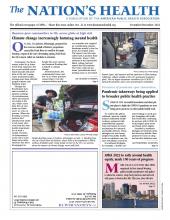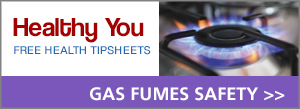
Ramon Lopez, lead operator and lab supervisor in Palm Springs, California, collects samples at the city’s wastewater treatment plant. The city began wastewater surveillance for COVID-19 during the pandemic and is now monitoring for monkeypox.
Photo courtesy City of Palm Springs
Some of the successful innovations and ideas put into place to battle the COVID-19 pandemic are now being put to good use on other public health work.
To combat the global outbreak, agencies rapidly trained community health workers, partnered with nontraditional organizations and turned to novel mechanisms for outreach and health delivery. Those strategies are now being adopted for public health work on substance use, disease surveillance and more.
In southeast Michigan, for example, a health care unit working to reach people struggling with addiction found that combining its services with COVID-19 work helped open doors and break down stigma.
Founded in southeast Michigan in February 2020, the Recovery Mobile Clinic planned to focus on drug and alcohol addiction treatment. But the pandemic struck a month later, causing it to reconfigure its offerings.
A startup nonprofit with 15 workers, a mobile unit and an ambulance, Recovery Mobile Clinic struggled to gain access to counties because of the stigma of addiction, said Jordana Latozas, RN, MSN, ACNP, clinic president. Adding COVID-19 testing and vaccinations broke down those barriers, enabling entry into seven counties in the Detroit area, initially to test people at homeless shelters for COVID-19. The unit also created partnerships with the Salvation Army, Detroit Rescue Mission Ministries, the Michigan Department of Corrections and several shelters.
Use of opioids, methamphetamine and alcohol is hurting people who are homeless in the Detroit area, but intervention is hard because of distrust of the health care system, Latozas said. COVID-19 testing turned out to be a way to start a conversation with people in need.
“We extend an olive branch with something simple, a COVID test, and then talk to them, show them respect and give them compassion,” Latozas told The Nation’s Health. “They start to trust us a little more, and then we can start asking some questions, such as how did you get here? They tell us about their addiction, then we start talking.”
Latozas said an important part of Recovery Mobile Unit’s success was showing up each week at the same place and time.
“Those patients that were on the fence would come back and ask me questions and think about (intervention),” she said. “They knew when and where to find us.”
The unit is also expanding into flu vaccinations and hepatitis treatments.
In Baltimore City, Maryland, the local health department hired over 80 people as COVID-19 vaccine ambassadors, who are trusted community messengers who talk to residents about vaccination. This summer, the health department adapted its COVID-19 outreach messaging to monkeypox vaccinations, bringing aboard ambassadors for that campaign as well, focusing on outreach to the LGBTQ community and promotion of vaccination events.
“It is critical to show it’s not necessarily just the health department or what feels sometimes like a government voice, but really, a neighbor or friend encouraging you to get vaccinated and answering the questions you have around the importance of vaccination,” Letitia Dzirasa, MD, commissioner of the Baltimore City Health Department, told The Nation’s Health.
The city’s COVID-19 social media strategy was adapted for monkeypox vaccination and COVID-19 boosters, both of which included open discussion and responses to frequently asked questions.
The Chicago Department of Health also improved its communications and outreach during the pandemic. In 2020, the department saw the limits of its tightly scripted messaging approach and switched to open, colloquial messaging about COVID-19 facts. The department hosted a Facebook Live session seven days a week, during which officials took questions from the public.
Several new staff were hired in the communications department, including a graphic designer to make public health data more engaging to Chicagoans.
This year, as the threat of COVID-19 diminished, the department’s Facebook Live morphed into a weekly roundtable addressing the pandemic and other public health issues.
“I have found that building trust comes from being open with people, showing you’re not afraid to take whatever questions they have, and admitting when you do not fully know something yet,” Allison Arwady, MD, MPH, commissioner of the Chicago Department of Public Health, told The Nation’s Health.
Since 2020, wastewater surveillance for COVID-19 has been used in several large U.S. cities. Wastewater data can suggest risk from coronaviruses, enabling health officials to mobilize in a community. Prior to COVID-19, Chicago had no wastewater surveillance of infectious diseases, Arwady said.

Workers with Michigan’s Recovery Mobile Clinic conduct community outreach. Combining substance use interventions with COVID-19 testing helped reduce stigma and reach residents.
Photo courtesy Recovery Mobile Clinic
But as of September, the city was conducting COVID-19 surveillance at 10 sewer sheds and preparing for surveillance of poliovirus and monkeypox virus, the latter of which had infected about 1,000 people in the city as of mid-September.
Perhaps most remarkably, the Chicago health department may have made a dent in the city’s gun violence problem by building on outreach and local partnerships established to vaccinate underserved communities for COVID-19. The approach also involves intervention, substance use and violence prevention, and mental and behavioral health efforts, Arwady said.
The city has focused on 15 communities burdened by poverty, incidence of violence and other challenges. Data show that homicides were down 22% in the communities this year when the programs were operating compared to 2021, and gun violence was down 23%. In North Lawndale, Austin and Greater Grand Crossing, gun shootings have fallen 37% this year.
“There’s a long way to go, but we’re encouraged by the trends,” Arwady said.
COVID-19 has also led to building up public health infrastructure at the local, state and federal level. One example at the state level is the Montana Public Health Institute, created in April 2020. One of 40 such institutes nationwide, the nonprofit supports public health agencies, health system partners, community-based organizations and others as they work to deliver public health programs and services.
“Stakeholders had been thinking about a public health institute for some time, but the pandemic really crystalized thinking on need and pushed everyone to hit the gas pedal and make it happen,” Matt Kelley, MPH, chief executive officer of the institute, told The Nation’s Health.
While it initially focused on COVID-19, the Montana institute has expanded its lineup of public health work, addressing health inequities, public health authority, crisis diversion, opioid overdose programs and other topics. It also connects local agencies with one another, as well as with state and federal health officials. In such a lightly populated, sprawling state like Montana, a way for people to connect locally was needed.
“The pandemic crystallized the need for this kind of connecting support, and we are now seeing that capacity being used on things that go beyond pandemic response,” Kelley said.
For more information, visit www.recoverymobile clinic.com and www.mtphi.org.
- Copyright The Nation’s Health, American Public Health Association









